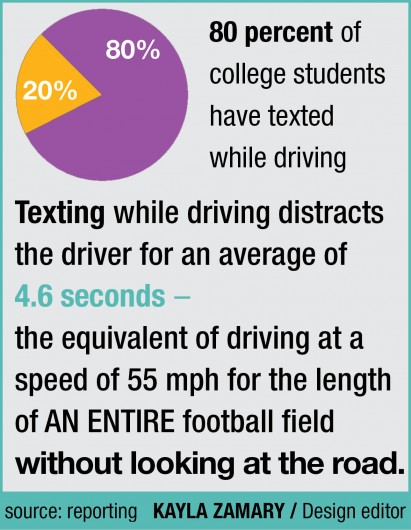
Four of five college students have texted while driving, according to research from King’s College in Pennsylvania.
The study’s main researchers Garold Lantz and Sandra Loeb also found male drivers are more likely to text while driving and tend to think of themselves as more proficient drivers than others on the road, leading them to believe they are less likely to endanger themselves or others.
“There seems to be a mentality that use of electronic devices is dangerous for everyone but ‘me,’” Lantz and Loeb said in a joint released statement.
The study by Lantz and Loeb was published in the “International Journal of Sustainable Strategic Management.”
Vaughn Bookheimer, a first-year in finance at Ohio State, said he knows a lot of people who text and drive but said it is dangerous.
“I don’t know anyone in (particular) who has caused an accident, but my cousin was hit by a driver who was texting and driving,” Bookheimer said.
Previous research has demonstrated that texting and driving increases the risk of getting into a car accident by 23 times the normal accident rate, according to Pediatric Academic Societies research. Additionally, a study in May by the Cohen Children’s Medical Center in New York also found that texting and driving has now surpassed drinking and driving as the leading cause of death among teenagers.
According to the medical center’s study, more than 3,000 teenagers die each year as a result of texting and driving and 300,000 are injured, while approximately 2,700 teenagers die from drinking and driving each year and 282,000 are injured.
Kaitlin Bradley, a second-year in strategic communication, said she is not surprised by the statistics about college students texting and driving.
“Even after a home football game, people are sitting in traffic and will pull out their phones because they think it’s not a big deal, even though it is,” Bradley said. “I know several people who have gotten into accidents because of it.”
Ohio has a ban on all cell phone use, handheld and hands-free, for drivers under the age of 18 or with a probationary driver’s license and a ban on texting for all drivers, according to “Distraction,” the official U.S. government website for distracted driving.
Lantz and Loeb reported personality traits and psychological tendencies of “impulsiveness” and a “need to be connected” are main driving factors in reasons why students engage in such behavior.
Hannah Herner, a first-year in exploration, said she signed an online pledge to not text and drive after being encouraged to by her dad.
“I really don’t think (texting and driving is) worth it,” Herner said. “I’m not really attached to my phone in general, but I think a lot of people really are and need to always respond (to text messages) immediately.”
According to research by the U.S. Department of Transportation, sending or receiving a text while operating a vehicle distracts the driver from the road for an average of 4.6 seconds – the equivalent of driving at a speed of 55 mph for the length of an entire football field without looking at the road, according to the study.


